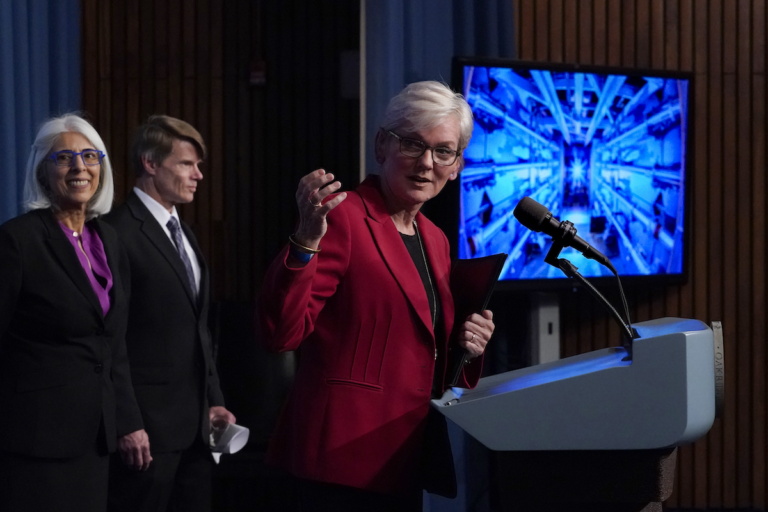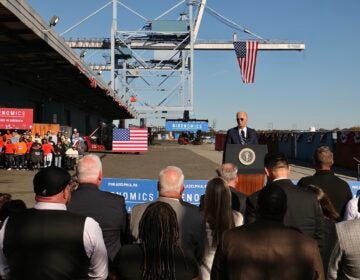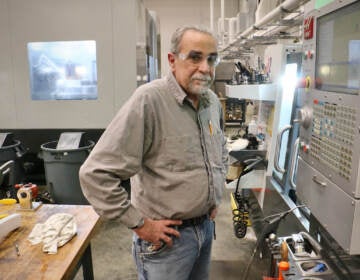Why the nuclear fusion ‘net energy gain’ is more hype than breakthrough
What does this “breakthrough” actually mean and why some are calling it a ‘scam.’

Secretary of Energy Jennifer Granholm, center, joined from left by Arati Prabhakar, the president's science adviser, and National Nuclear Security Administration Deputy Administrator for Defense Programs Marvin Adams, discusses a major scientific breakthrough in fusion research that was made at the lab in California, during a news conference at the Department of Energy in Washington, Tuesday, Dec. 13, 2022. (AP Photo/J. Scott Applewhite)
It’s been a long week for science writer and author Steven Krivit.
“Look, when my mother calls me and asks me about nuclear fusion news, then I know there’s a lot of buzz going on out there,” Krivit said.
By now, you’ve probably heard the news, too. This week, U.S. Department of Energy officials announced that the National Ignition Facility at the Lawrence Livermore National Laboratory in California finally attained “fusion ignition” – a long-awaited achievement for nuclear fusion researchers around the globe.
The lab’s press release called it a “potentially world-changing breakthrough” in the quest for “limitless” energy that might “set the stage for fusion to someday become a viable clean-energy option.” Countless media outlets were happy to repeat the good news in big bold headlines and urgent push notifications.
But what does this “breakthrough” actually mean? Does it really live up to the hype? That’s what Krivit’s mother, brother, cousin, and readers all wanted to know. And they turned to him for answers.
Since 2000, Krivit has reported on the promise and pitfalls of nuclear energy on his website New Energy Times. He’s the first to admit he’s no scientist, but he’s spent a lot of time speaking with scientists about their work. So much so, that when word first started to spread about this recent “breakthrough,” at least one scientist turned to Krivit to commiserate.
“I hang my head in shame over the behavior over the last few days of my fellow scientists,” one of Krivit’s readers wrote to him.
Why was the reader so disappointed? Because, as Krivit and his reader concluded, this fusion “breakthrough” was nothing more than a “scam.”
To be clear, the science behind the experiment wasn’t the problem.
Subscribe to The Pulse
Researchers at NIF really had pointed several lasers at a tiny pellet full of hydrogen isotopes, which in turn fused their atoms together.
And their result really was newsworthy – it was the first time such a reaction gave off more energy (3.15 megajoules) than had been injected directly into the fuel (2.05 megajoules).
No, the science wasn’t bad or incorrect. Rather, the disappointment was over the scientific details, the fine print, buried below the headlines and left out of the lab’s press release and events, and how those details contradict claims that this “breakthrough” may provide a “pathway to pilot commercial fusion plants in the coming decades.”
“They completely omitted the power to operate [the entire device],” Krivit said.
Krivit says the frequent use of the term “net energy gain” by boosters of NIF without further explanation is highly misleading. While technically correct in reference to the reaction itself, once translated into the sweeping context of “limitless energy,” the result reads more like a curiosity than a world-changing breakthrough.
That’s because, all-in-all, the entire device took about 400 megajoules to operate during the experiment. That means it lost about 99% of the power it consumed. That is pretty far from a net energy gain.
“Practically speaking, the result is irrelevant.” Krivit wrote on his site. “The NIF device did not achieve net energy. The scientists who are promoting this result to the news media are playing word games.”
I first spoke with Krivit over a year ago to chat about similar word games coming from another major fusion project: The International Thermonuclear Experimental Reactor.
Touted as the “world’s largest science experiment”, ITER is several decades in the making and still years away from becoming operational. It will use a different method to spark fusion than NIF, but, ITER also made some extraordinary claims about what its results could mean for the future of fusion energy.
The organization promised the project would demonstrate that commercial fusion was feasible (ITER is latin for “the way”) by producing 10 times more energy than it consumed. Indeed, such claims helped convince governments across the globe to fund the project.
And why wouldn’t they? It all sounded great – potentially limitless energy!
But, once more, a deeper dive into the numbers revealed that things were more complicated than ITER was letting on. Again, while the power gain claims were technically true when it came to the reaction within the reactor, the organization omitted crucial information from its marketing materials.
As one scientist at ITER later admitted, the true power output for the whole operation would ultimately equal the same amount of power it took to run the reactor. That meant no overall net power gain and very little proof that commercial fusion was feasible.
So why did the ITER organization slap the 10-time power gain claim all over its marketing materials?
“People just accepted this.” Michel Claessens, the former director of communications for ITER told me. “And because it was, let’s say, a good selling argument — voila.”
Eventually, ITER softened its claims.
The U.S. Department of Energy estimates that ITER will cost the international community $65 billion to complete.
Thus far, NIF has cost U.S. taxpayers at least $13.5 billion.
But unlike ITER, the facility never promised to demonstrate the viability of commercial fusion. In fact, NIF’s true value to the U.S. government is derived from its ability to test nuclear weapons without actually testing nuclear weapons. Currently, NIF is “the only facility that can perform controlled, experimental studies of thermonuclear burn, the phenomenon that gives rise to the immense energy of modern nuclear weapons.”
Despite all of this, Krivit points out the lofty comparisons to NIF’s recent “breakthrough” to that of the Wright brothers’ first flight continue (at least the brothers knew they’d have enough fuel to get the new industry off the ground). Though, Krivit does believe his attempts to throw cold water on the dramatic announcement have made an impact.
When asked, an NIF spokesperson would not say whether NIF researchers worried their findings were overstated.
But as for the rest of us, staring down a future that is neither limitless nor clean, hope, hype, and a few more billion dollars toward a likely dead end is all we can seem to muster.
Meanwhile, Steven Krivit is running out of ways to phrase the bad news: “There’s no there, there.”
WHYY is your source for fact-based, in-depth journalism and information. As a nonprofit organization, we rely on financial support from readers like you. Please give today.







